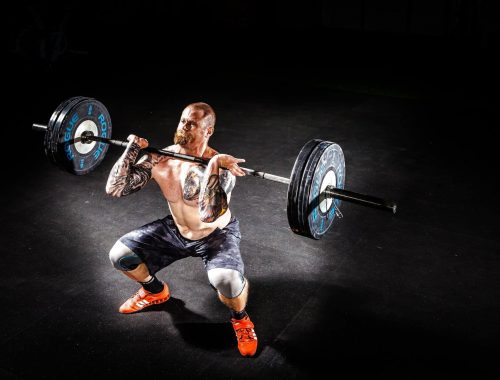Balancing Cardio and Strength Training for Optimal Muscle Growth
Many people who exercise and participate in physical activity have essential goals in mind, including muscle growth and overall physical fitness. While both cardio and strength training are necessary for a well-rounded fitness regimen, finding the ideal balance between the two can be difficult. The good news is that you can design a workout program that encourages optimal muscle growth while still offering the cardiovascular advantages you want with a little bit of forethought and understanding of how each type of exercise affects the body.
The key distinctions between aerobic and strength training, the reasons why both are crucial for muscle growth, and how to balance the two for the greatest outcomes are all covered in this article.

What is Cardio?
Exercise that improves blood flow to the muscles and elevates heart rate is referred to as cardio exercise. Running, cycling, swimming, and jumping rope are a few examples of what this can include. Cardiovascular fitness is the main goal of the exercise, but it also offers other advantages including bettering general health, lowering the risk of certain diseases, and helping with weight loss.
What is Strength Training?
Resistance is used during strength training to push the muscles and increase strength, power, and muscle mass. Numerous techniques, like as bodyweight workouts, resistance band training, and weightlifting, can be used to accomplish this. Strength training’s main goal is to increase muscular mass, but it also has side effects that include boosting metabolism, enhancing bone density, and lowering the chance of injury.
Why Both Cardio and Strength Training is Important for Muscle Growth
Cardio and strength training each have particular advantages and can work in tandem to encourage the best possible muscular growth. Let’s examine the benefits of both forms of exercise in more detail:
- Cardio helps to enhance blood flow because it speeds up your heartbeat, which enables more oxygen and nutrients to reach the muscles. With faster muscle recovery following a strength training session, you can return to the gym earlier and gradually gain more muscle mass
- Strength Training Builds Muscle: The stress placed on the muscles during strength training exercises results in little tears in the muscle fibers. As the tears heal and get stronger, the muscle mass and strength rise
- Cardio Exercise Burns Calories: Cardio exercise helps people lose weight by burning calories. Cardio can assist you in maintaining a caloric deficit, which is necessary for developing muscle because it burns calories. The body can generate muscle when there is a caloric deficit, which is when you consume fewer calories than you burn each day
- Strength training has a significant impact on metabolism, keeping it raised for hours after an exercise. This makes it simpler to maintain a caloric deficit and gain muscle since you continue to burn calories even after your workout is over
Balancing Cardio and Strength Training for Optimal Muscle Growth
Now that we understand the benefits of both cardio and strength training, let’s explore how to balance the two for optimal muscle growth:
- Start with a Strength Training Foundation: Strength training should be the foundation of your workout routine, as it provides the most direct benefits for muscle growth. Aim to perform strength training exercises at least three times a week, focusing on compound movements that work for multiple muscle groups at once.
- Incorporate Cardio into Your Routine: After you’ve established a solid strength training foundation, it’s time to add cardio to your routine. Incorporate cardio exercises that complement your strength training goals, such as running or cycling. The frequency and intensity of your cardio will depend on your individual goals but aim for at least two sessions of moderate-intensity cardio each week.
- Vary the Intensity and Duration of Your Cardio Workouts: To maximize the benefits of cardio for muscle growth, it’s important to vary the intensity and duration of your workouts. For example, you can perform short, high-intensity interval training (HIIT) sessions to improve cardiovascular fitness and burn calories, as well as longer, moderate-intensity endurance sessions to help with recovery and reduce the risk of injury.
- Allow for Rest and Recovery: Both cardio and strength training put stress on the body, and it’s essential to allow for proper rest and recovery. Aim to give your muscles at least 48 hours of rest between strength training sessions to allow for maximum growth. Additionally, make sure to properly stretch and foam roll after both cardio and strength training sessions to reduce the risk of injury and promote recovery.
- Adjust as Needed: As you progress in your fitness journey, it’s important to continually reassess your goals and adjust your workout routine accordingly. This might mean increasing the intensity or frequency of your workouts, trying new exercises, or incorporating new types of cardio or strength training.
It’s critical to combine cardio with strength training for the best results in terms of muscle growth and general fitness. You can gain the advantages of enhanced cardiovascular fitness, increased muscular mass, and a boost to your metabolism by mixing both types of exercise into your program. Just keep in mind to start with a foundation of strength training, including cardio in a way that supports your goals, allows for adequate rest and recovery, and regularly reviews and changes as necessary. You can quickly reach your fitness and muscular building objectives with a little bit of preparation and work!
You May Also Like

10 Essential Exercises for Building Muscle
February 1, 2023
Role of Sleep and Recovery in Building Muscle
February 4, 2023


